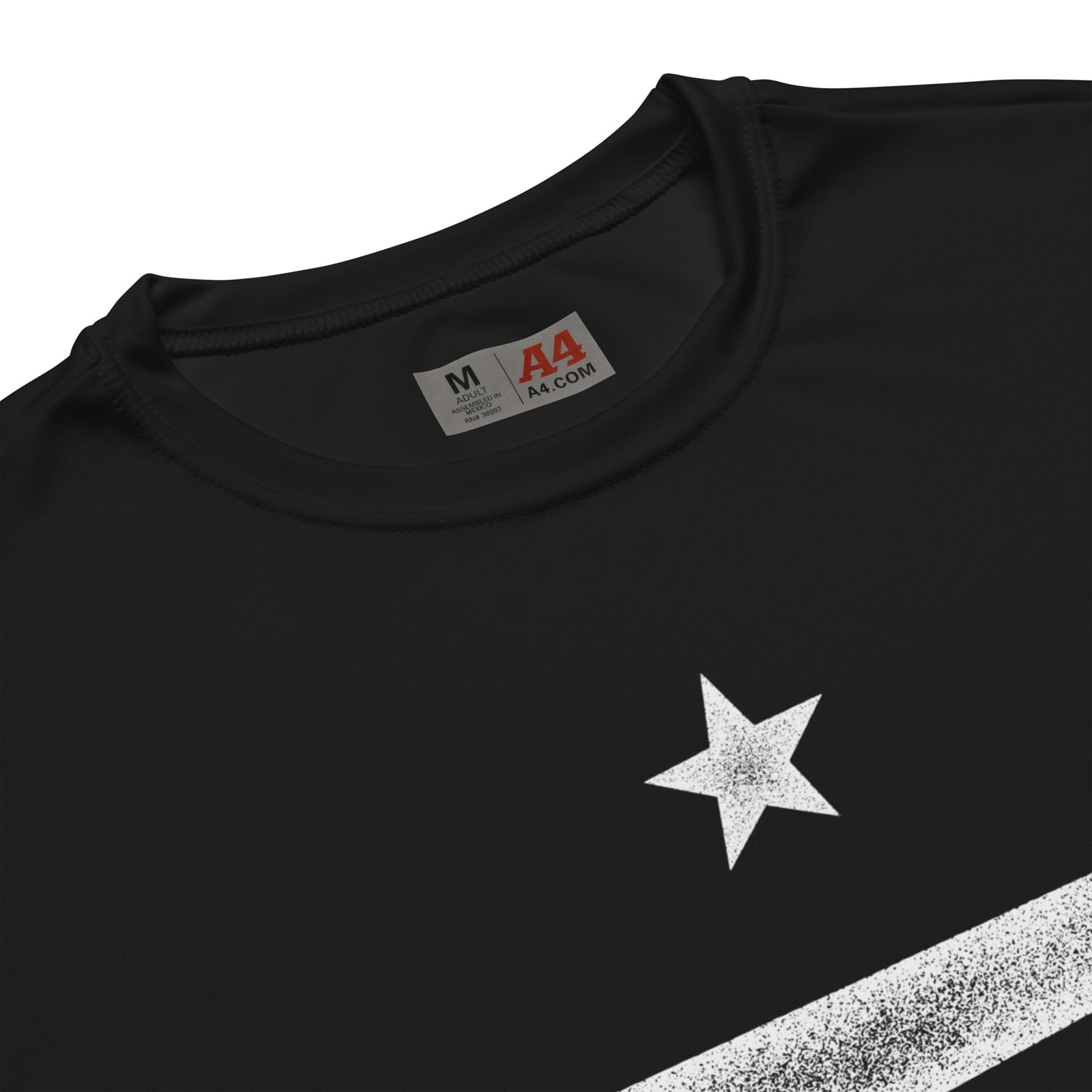










Gonzalez Come and Take It Unisex Performance T-Shirt
The Gonzales "come and take it" cannon was a Spanish-made, bronze artillery piece of six-pound caliber. The gun was the object of contention in late September and early October 1835 between a Mexican military detachment from Bexar and Anglo-Celtic colonists. The disagreement produced the battle of Gonzales, considered to be the first battle of the Texas Revolution. On January 1, 1831, Green DeWitt initiated the new year by writing Ramón Músquiz, the political chief of Bexar, asking him to make arrangements for a cannon to be furnished to the Gonzales colonists for protection against hostile Indians. On March 10, 1831, after some delay, James Tumlinson, Jr., a DeWitt colonist at Bexar, received one bronze cannon to be turned over to Green DeWitt at Gonzales. The fact that the gun was not carriage mounted until about September 28, 1835, suggests that in 1831 it was probably swivel mounted in one of the two blockhouses that had been constructed at Gonzales in 1827. Thus mounted it would have served as a visual deterrent to hostile Indians.
The cannon is lost to history until September 1835, when Col. Domingo de Ugartechea, the military commander at Bexar, sent Corporal Casimiro De León and five soldiers of the Second Flying Company of San Carlos de Parras to retrieve the cannon. The Gonzales colonists notified Ugartechea they were keeping the gun and took the soldiers prisoner. The cannon was then buried in George W. Davis's peach orchard and couriers sent to the Anglo-Celtic settlements on the Colorado River to obtain armed assistance. Ugartechea responded by sending 100 troops under Lt. Francisco de Castañeda to make a more serious request for the return of the gun. On September 29, Capt. Robert M. Coleman arrived at Gonzales with a militia company of thirty mounted Indian fighters. The gun was retrieved from its shallow grave, taken to John Sowell's blacksmith shop, and mounted on a pair of cart wheels. After the organization of the Texian "Army of the People" under Gen. Stephen F. Austin, the cannon was assigned to Capt. James C. Neill's artillery company and hauled to San Antonio. After the capture of Bexar in December 1835, the cannon remained at the Alamo, where it was one of twenty-one artillery pieces commandeered by the Mexican army upon the recapture of Bexar on March 6, 1836.
The name "Come and Take It" refers to the motto adopted by the Texian rebels. On the morning of October 2, 1835, Lieutenant Castañeda requested the cannon be returned to the Mexican military-a condition on which it had been loaned to DeWitt's Colony-but the Texians pointed to the gun which stood about 200 yards to their rear, and said, "there it is-come and take it." Soon after the conflict began, at the request of the Anglo-Celtic leaders, the ladies of the settlement hastily made a flag to fly over the cannon. The flag featured a white ground with a black cannon in the center, and the motto "Come and take it!" above and below. Much has been made of an account that appears in Noah Smithwick's The Evolution of a State or Recollections of Old Texas Days (1900), in which Smithwick identifies the cannon as an iron six-pounder. This is the only account, however, of events at Gonzales in October 1835 that identifies the Gonzales gun as being made of iron. Primary documents indicate that the gun probably was a cannon belonging to George Huff, a blacksmith, and gunsmith from San Felipe. Another discovery claim concerning the Gonzales cannon came into being after a major flood in July 1936, when a small iron salute cannon was discovered downstream from Hardy's Bluff on Sandies creek. Many individuals believe the small salute gun is the Gonzales cannon because it was found at a location that appears to match the information in the Smithwick book. The gun, however, matches none of the characteristics attributed to the Gonzales cannon by reliable primary sources. The Smithwick account incorrectly identifies the Gonzales cannon, but the Sandies salute gun does not even conform to Smithwick's description of the cannon he believed to be the Gonzales gun. Although what happened to the "Come and Take It" cannon is not known, still another, and probably more likely scenario, resulted from actions of the Mexican army after the fall of the Alamo, when Antonio López de Santa Anna's troops melted down an unknown number of bronze guns. The Gonzales cannon may have been one of these.
Stay cool, dry, and confident even during the most intense activities in this unisex performance crew neck t-shirt. Made from premium, moisture-wicking fabric with odor resistance, stain release, and UV protection, this shirt’s perfect for going to the gym, playing sports, hiking, or any other activity.
• 100% premium polyester
• Fabric weight: 0.12 oz/yd² (4 g/m²)
• Soft, moisture-wicking fabric
• Fade and snag resistant
• Relaxed fit
• UPF44+ protection
• Reinforced shoulder seams
Size guide
| LENGTH (inches) | CHEST (inches) | SLEEVE LENGTH (inches) | |
| S | 27 ½ | 36-39 | 18 ½ |
| M | 28 ½ | 39-42 | 19 ¼ |
| L | 29 ½ | 42-45 | 20 |
| XL | 30 ½ | 46-49 | 20 ¾ |
| 2XL | 31 ½ | 50-53 | 21 ½ |
| 3XL | 32 ½ | 54-57 | 22 ¼ |
| 4XL | 33 ½ | 58-61 | 23 |
| LENGTH (inches) | CHEST (inches) | SLEEVE LENGTH (inches) | |
| S | 27 ½ | 36-39 | 18 ½ |
| M | 28 ½ | 39-42 | 19 ¼ |
| L | 29 ½ | 42-45 | 20 |
| XL | 30 ½ | 46-49 | 20 ¾ |
| 2XL | 31 ½ | 50-53 | 21 ½ |
| 3XL | 32 ½ | 54-57 | 22 ¼ |
| 4XL | 33 ½ | 58-61 | 23 |
Collections: Father's Day, Gun Range Gear, Independence Day | Every Day Is Independence Day at Liberty Maniacs, Ladies Tops | Women's Premium Shirts and Sweatshirts, Liberty Maniacs Athletics, New Arrivals, Performance Apparel, The Best Libertarian Shirts | The World's Favorite Libertarian Apparel, Vintage Collection
Type: Performance Shirt
Category: america, athletic, austin, black, cannon, come and take it, crew neck, grey, gun, historical, history, labe, libertarian, liberty, liberty maniacs, men, mens, moisture wicking, molon, molon labe, performance, Performance Shirt, short sleeve, star, texan, texas, tshirt, vintage


















